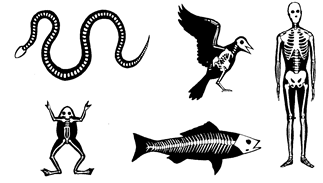

French, bean, gram, pea and mango are the examples of………….seed.
a) Monocotyledonous
b) Dicotyledonous
c) both a & b
d) None of these
Animals are divided in to two large sub groups. 1) Vertebrates 2)
Invertebrates

Vertebrates:
Ø Vertebrates are those animals which have backbone
in their body.
Ø Vertebrates are further divided in to five classes.
Ø 1) Fishes: Fish live in water
and respire by gills. There are many kinds of fishes like shark,
Trout, Grass Carp; Rohu etc. are the example of fishes.
Ø 2) Amphibians: Amphibians can live
both in water and on land. Mostly their skin is moist and slippery. Examples
Frog, toad etc.
Ø 3) Reptiles: Reptile is
completely land vertebrates. They lay eggs on land. Their skin is
hard and rough. Example Snake, Crocodile, Tortoise
etc.
Ø 4) Birds: The body of birds is
covered with feathers. Birds can fly easily with the help of their strong
wings. Example Sparrow, eagle, parrots etc.
Ø Some birds cannot fly but run, they are called running
birds. Examples kiwi, ostrich.
Ø 5) Mammals: These vertebrates
give birth to young ones and the mother feeds the babies
with her milk. They have hairs on their bodies. Example Goat, Cow,
Buffalo, etc.
Ø Human beings are
also mammals.
Ø Dolphin and whale are mammals.
Ø Bat is a unique mammal that can fly in air.
Ø Ostrich is
the largest birds of the world.
What is true about vertebrates?
a) All have lungs
b) All have gills
c) All have backbone
d) All have joined legs
Vertebrates are further classified into……. major groups.
a) Two
b) Four
c) Five
d) Seven
Fish breathe through;
a) Lungs
b) Skin
c) Gills
d) Mouth
Which one of the following are included in invertebrates?
a) Fish and birds
b) Birds and jelly fish
c) Jelly fish and earth worms
d) Snails and snakes